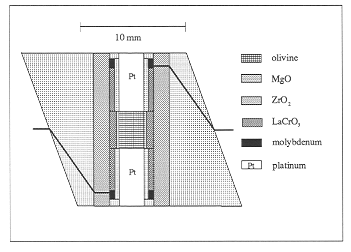

The most precise information available about the properties of the Earth's interior are seismic wave velocities obtained from earthquakes or artificial explosions. Earth scientists are interested in reproducing observed seismic wave velocities in the laboratory at high pressures and temperatures using different proposed mantle mineralogies in order to test for the applicability of existing pressure, temperature and composition models of the Earth. To derive seismic velocities at conditions of the deeper Earth, studies have been performed in the past which normally determined either the pressure dependence of wave velocities or their temperature dependence. To derive the dependence of velocity "v" on pressure and temperature simultaneously, and in particular the second derivative ∂ 2v/∂ P∂ T, those different data sets needed to be combined and extrapolated, which results in relatively large uncertainties. We have developed a technique which allows us to propagate ultrasonic waves through materials at simultaneous high pressure and temperature, i.e. at conditions of the Earth's interior without extrapolation.
The experiments are performed in the multi-anvil press. The multi-anvil
sample assembly was modified in order to be able to propagate both compressional
and shear waves through a sample at simultaneously high pressure and high
temperature (Fig. 3.10-3). In experiments up to 10 GPa and 1500 °C
this assembly consists of an octahedron with 18 mm edge length, in which
a stepped resistance heater of LaCrO3 is used to reach high
temperatures. The cylindrical sample, 2.5 - 3.5 mm long with a diameter
of 1.7 mm, lies in the middle of the octahedron. Platinum buffer-rods are
attached to each end of the sample. The platinum buffer-rods survive high
temperatures and behave plastically under high pressures; therefore they
are well suited for these experiments.
 |
Fig. 3.10-3: High pressure multi-anvil assembly. The sample and platinum buffer rods are shown together with the stepped LaCrO3 heater and the molybdenum electrical connections to the heater. |
The Pt buffer-rods are in contact with WC cubes which are truncated on one corner in order to leave a space in which the octahedron can be accommodated. These cubes transmit the pressure to the octahedron. The transducers are glued to the diagonally opposite corner of the cubes to that which is in contact with the Pt buffer-rod and which is truncated in the same fashion. In doing so the transducers stay outside of the high pressure environment and are subjected to neither stress nor high temperatures. With this setup the ultrasonic waves can be transmitted from outside the pressure assembly through the WC cube and the Pt buffer rod to the sample.
In order to determine sound velocities, ultrasonic interferometry measurements were performed in which the signals from the buffer-rod and the sample interfaces are overlapped. This method has the advantage that only the interface between the buffer-rod and the sample has to be considered. Due to the high pressure exerted onto the assembly this interface is in good mechanical contact.
The first measurements of compressional (p-) and shear (s-) wave velocities
in the frequency range 10 - 30 MHz have been successfully performed on
polycrystalline San Carlos olivine at room temperature up to 8 GPa and
in the temperature range 25° - 1500 °C at pressures up to 10.5
GPa (Fig. 3.10-4). The length of the sample before and after pressurization
is the same. This is interpreted to show that only elastic deformation
has taken place in the sample and that the pressure environment is near
to hydrostatic. Plastic deformation during pressurization appears to be
taken up entirely by the platinum buffer rods which are shortened by ~
25 % during an experiment to 10 GPa. Mere elastic deformation in the sample
allows us to calculate the length of the samples at high pressures precisely.
 |
Fig. 3.10-4: The ultrasonic interference patterns obtained for p- and s-waves at 1500 °C and 10.5 GPa as a function of frequency. The data are obtained from the addition of the signal through the platinum buffer-rod and the signal through the polycrystalline olivine sample. |
Full sets of measured p- and s-wave velocities at the same P,T conditions during an experiment on the same sample will allow us to calculate the density and bulk modulus of the sample independent by of pressure and temperature. Adaptation of the same technique to the smaller multi-anvil assembly with a 14 mm edge length will allow us to go to pressures up to 15-16 GPa. These are the pressure conditions of the mantle transition zone in which a sudden increase of seismic velocities is observed. This increase is thought to be due to the transition of α -(Mg,Fe)2SiO4 (olivine structure) to ß -(Mg,Fe)2SiO4 (modified spinel structure) at this pressure. Direct determination of the sound wave velocities in the multi-anvil press under these conditions in α -olivine and ß -phase should give us an answer of whether or not this is indeed a viable possibility. This technique also has the potential to be applied to single crystal materials and melts and thus opens up a wide range of possible in-situ measurements at high pressures and temperatures.

Tel: +49-(0) 921 55 3700 / 3766, Fax: +49-(0) 921 55 3769, E-mail: bayerisches.geoinstitut(at)uni-bayreuth.de
 Previous page
Previous page